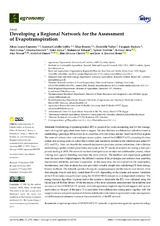Developing a regional network for the assessment of evapotranspiration
Autor
López-Guerrero, Alicia
Cabello-Leblic, Arantxa
Fereres Castiel, Elías
Vallee, Domitille
Steduto, Pasquale
Jomaa, Ihab
Owaneh, Osama
Alaya, Itidel
Bsharat, Mahmoud
Ibrahim, Ayman
Abla, Kettani
Mosad, Alaa
Omari, Abdallah
Zitouna-Chebbi, Rim
Jimenez-Berni, Jose A.
Editor
MDPIFecha
2023Materia
EvapotranspirationCORDOVA-ET
ET network
Irrigation management
Agrometeorology
METS:
Mostrar el registro METSPREMIS:
Mostrar el registro PREMISMetadatos
Mostrar el registro completo del ítemResumen
Determining evapotranspiration (ET) is essential for water accounting and for the management of irrigated agriculture from farm to region. We describe here a collaborative initiative aimed at establishing a prototype ET network in six countries of North Africa and the Near East (NENA region). The network utilizes a low-cost and open-source system, termed the CORDOVA-ET, consisting of a base station and sensing nodes to collect the weather data needed to determine the reference and actual ET (ETo and ETa). Here, we describe the network-deployment processes, system architecture, data-collection methodology, quality-control procedures, and some of the ET results obtained so far during a four-year period, starting in 2018. The network has been developed as an iterative and collaborative process, where training and capacity building have been the main drivers. The feedback and experiences gathered from the users have helped improve the different versions of the prototypes and enhance their assembly, deployment, reliability, and ease of operation. At the same time, the involvement in the construction, maintenance, and data analysis has also provided valuable insight into calculating ET from energy-balance methods. The network operated during six cropping seasons and the results were mixed, while data integrity (hourly and daily) varied from 95 to 23% depending on the country and season. Validation of the ET estimates was performed using the ECMWF ERA5 dataset as an independent reference. The energy-balance algorithm implemented in the system to determine the ETa was validated using the OpenCropLib Python library. While the results of the data validation demonstrated the reliability and accuracy of the CORDOVA-ET system, network operations required significant support and special motivation on the part of the users. It is concluded that collaboration among users, together with the support services and participation of different stakeholders interested in agricultural water management, would be essential elements to ensure the sustainability of the ET network.

